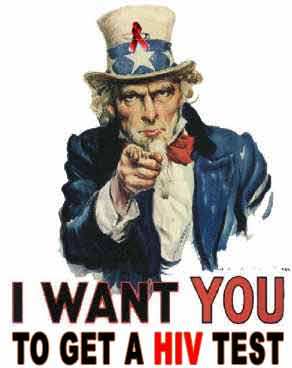An ongoing dialogue on HIV/AIDS, infectious diseases,
June 23rd, 2010
Combined HIV Antibody/Antigen Test Approved
 From the FDA:
From the FDA:
The U.S. Food and Drug Administration today approved the first assay to detect both antigen and antibodies to Human Immunodeficiency Virus (HIV)… The highly sensitive assay is intended to be used as an aid in the diagnosis of HIV-1/HIV-2 infection, including acute or primary HIV-1 infection. Since it actually detects the HIV-1 virus (specifically the p24 antigen) in addition to antibodies to HIV, the ARCHITECT HIV Ag/Ab Combo assay can be used to diagnose HIV infection prior to the emergence of antibodies.
This is definitely progress, as it seems fairly obvious that combined antibody/antigen detection is how we should optimally be diagnosing HIV infection.
The fact remains that despite the increased sensitivity of antibody testing, some HIV cases are still missed when patients present with recently-acquired infection, too soon after viral transmission to have detectable antibody. One acute case we saw recently had reactive ELISA, but a completely negative Western blot — anecdotally this is becoming an increasingly common “negative” HIV test since ELISA has cranked up the sensitivity so much.
The two settings where this new test might be particularly useful are in high-prevalence populations (where the incidence is higher) and when people seek testing soon after a risky exposure.
Remaining questions include the cost of the new assay (both in literal terms and in lab personel resources), the predictive value of a reactive result in low risk settings, and how the p24 antigen here compares in sensitivity with HIV RNA measurement (our usual way of detecting acute HIV). On the last issue, at least one past study suggested that p24 was less sensitive than HIV RNA, but that was a long time ago.
(FYI, June 27 is National HIV Testing Day. Apologies for the grammatical error — “a HIV test” — in the above image, I love the poster.)


You mention that negative Western Blots are becoming increasingly common. Under what condition would a negative Western Blot be acceptable as evidence of a false positive Elisa(of 4th generation)? I have read several articles on this and I am confused as it seems many doctors are saying the Western Blot is no longer useful as a confirmatory diagnostic tool because of its lack of sensitivity. So if a patient admits to a hospital 3 months post exposure and tests positive on a 4th generation test and then negative on a Western Blot(and a separate p24 test), how would you interpret that?
Mr. A,
Western blot is definitely still an acceptable form of confirmatory testing in the vase majority of established (i.e., not recently-acquired or acute) HIV infections. It’s in HIV of recent onset that the lower sensitivity of WB compared with ELISA has become an issue. In the particular case you describe, I would suggest measuring HIV RNA (viral load) or a qualitative HIV RNA assay, as it’s possible that both the negative WB and p24 antigen are false negatives.
Paul
Dr. Sax, out of curiosity, can you please elaborate on the length of time post-infection that would put a patient into the “established” category? I always assumed that by 3 months the Western Blot would be fine for confirmation, and that the acute/recently-acquired phase was only the first 6~ weeks post infection where it would give a negative or indeterminate response. In a situation where a patient winds up with the above circumstance, and can’t afford a PCR or is in a resource limited situation, are there any other testing algorithms you might suggest, or would another antibody test at a later date suffice?
Dear Concerned,
Best paper on timing of seroconversion, etc is here:
http://tinyurl.com/clj28q8
Fiebig EW, et al.
Dynamics of HIV viremia and antibody seroconversion in plasma donors: implications for diagnosis and staging of primary HIV infection. AIDS. 2003 Sep 5;17(13):1871-9.
Obviously there are between-individual variations.
Paul